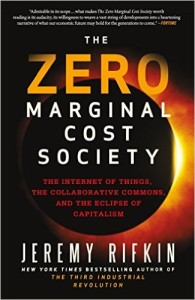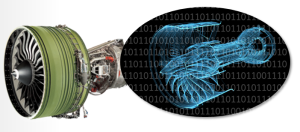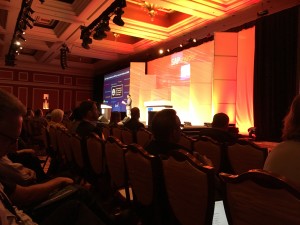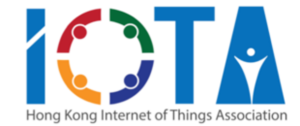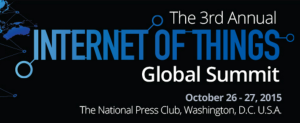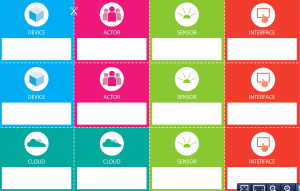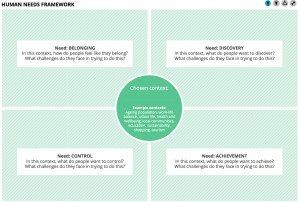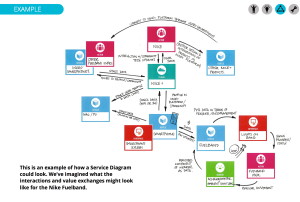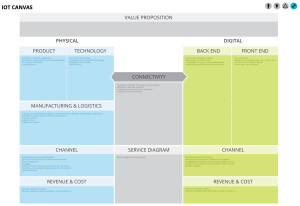I’m back in Sodom and Gomorrah in the desert, AKA Las Vegas, to speak at another SAP IoT conference: SCM CRM IoT 2016, and to live blog again!
Keynoters: Hans Thalbauer, sr. vp of extended supply chain solutions at SAP, and Dr. Volker G. Hildebrand, global vp or customer engagement & commerce for SAP Hybris:
Hildebrand:
- theme: move beyond traditional CRM: look at entire customer journey
- you have to meet customer expectations for convenience, relevance, reliability, and in real-time.
- real lesson from Uber: customers upend markets, not companies; carry power of internet in their pocket; if you’re fighting alone, you have no chance of success;
- when London cabbies went on strike, Uber membership went up 850% in 3 days.
- “74% of execs. believe digital transformation is improving value for customers”
- must thinking beyond CRM: 2 of 3 companies don’t think their CRM doesn’t support their future needs for customer engagement.
- blend marketing & commerce.
- personalization is key to digital commerce.
- beyond service: customer served before, during & after buy; flawless field service. 53% abandon online purchase if they don’t be quick answers to questions.
- why no app from cable provider allowing you to get assistance Uber-style? Instead, hold on phone.
- One-to-one future is here.
- Omnichannel selling
- By 2020: 1 million fewer B2B sales reps (@Forrester)
- EY: enabled collaboration with 15,000 client partners
- “Engage your customers like never before:” commerce, marketing, service & sales.
Bob Porter, Pregis (protective packaging):
- liked ease of use with Hybris (vs. Salesforce)
Thalbauer (digital transformation of supply chain):
- end-consumer driven economy
- very related to IoT
- tech adoption accelerating
- biz model transformation
- instant notification if the equipment malfunctions
- change of business transformation
- disruption in every aspect of business:
- customer-centric (demand sensing, omni-channel sales, same-day delivery)
- individualized products (configured products, digitalized inventory, lot size of one)
- resource scarcity (talent, sustainability, natural resources)
- sharing economy (social networks, business networks, asset networks)
- sweet: combo of 3-D printing at warehouse & Uber-based model for final delivery.
- extended supply chain demo: sweet (literally): 3-D printing of chocolates at high-end stores! — wonderful example of IoT data-centric enterprise
- SAP increasing pace of innovation
- fastest-growing planning solution in history
- only live logistics platform in the market
- product innovation platform re-defined
- demand-driven manufacturing
- digital assets.
Next up: Sacha Westermann, Port of Hamburg, on how it uses IoT to streamline operations, improve efficiency & reduce accidents through “smartPORT”:
- it’s very big (largest port in Germany), and very complex! Ships, rail (largest rail hub in Europe), trucking. 24/7.
- big emphasis on environment: need to reduce emissions, improve sustainability.
- can’t expand area, but must be able to handle more volume.
- key factor is connectivity between all parties.
- smartPORT includes energy & logistics.
- smart maintenance: use mobile to call up SAP order & create messages, take photos. Example of malfunction with a drawbridge. Technician got new button from stock, installed it, customers didn’t even know there was a problem.
- port monitor: digital map with all info to operate the harbor. Mobile version on iPad.
- SmartSwitch for rail: sensors on the switches to measure conditions. Automated data flow to maintenance company.
- dynamic info on traffic volumes: combines all real-time data on traffic. Detects available parking spaces. Created “PrePort Parking” as holding area for trucks that are early or late. Trucks park bumper-to-bumper for maximum efficiency.
- special traffic lights: cycle changes based on real-time traffic flow. Warning messages if pedestrians cross.
- smartROAD: smart sensing of the bridge-structural load — identifies interdependencies and to do predictive maintenance.
- Take aways:
- good application requires lot of data
- must share data
- data privacy critical for confidence
- everyone gets just info they need
- more participants, higher the benefit for each
- open interfaces basic
- application must be self-explanatory
Next up: me!, on 4 Essential Truths of IoT & how that translates into strategy.
Mike Lackey, IoT Extended Supply Chain, SAP explaining their IoT strategy & direction, with emphasis on “driving customer value”:
- he’s using universe of 75 billion connected devices by 2022.
- case study: STILL, the smart lift truck from Germany. Forklift sold as service, based on weight of materials carried. They will communicate among themselves, M2M.
- “It is not about Things, it is about what the Things can do to radically transform business processes!”
- oil & gas: reducing spills. They worked with the company that made the platform that failed in Deep Horizon — hadn’t been maintained in years.
- Burbury: want to know exactly what you looked at, share the info among their stores. Creepy: invasion of privacy??
- UnderArmour: why do you have to wear a band — build sensors right into clothes.
- Hagleitner (I reported about them at last SAP event) provides supplies for corporate washrooms, etc. Paradigm shift: sensors let them know which dispensers need new materials. “big washroom data“
- applications: drive adoption with a few killer applications. Differentiate with “Thing to Outcome”
- cloud: leading cloud experience for customers and partners at lowest TCO
- platform: open big data platform. high-value services for SAP, customer & partner
- Kaeser Compressors also made paradigm shift: no longer sell air compressors, but air — must guarantee it works constantly. Million data points per compressor daily. Differentiates them from competitors.
- one tractor company now can recommend to farmers what they should plant based on data from sensors on the plows.
- Asset Intelligence Network: great example of data sharing for mutual advantage. To be released soon.
- Enables connected driving experience.
- SAP IoT Starter Kit can get you started.
